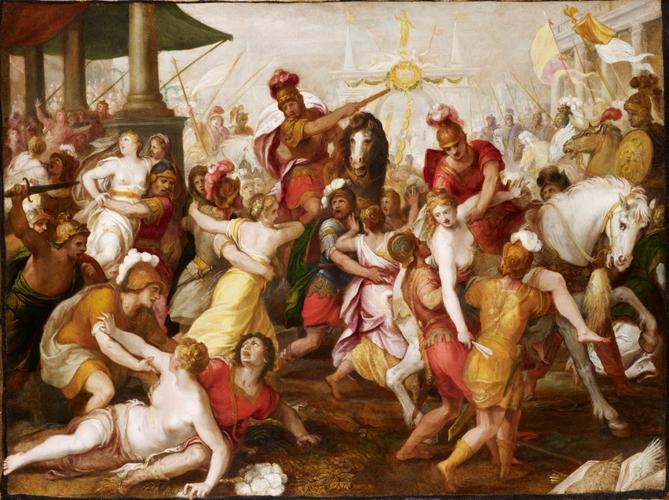-
1 of 253523 objects
The Rape of the Sabines c. 1573
Oil on canvas | 76.5 x 101.8 cm (support, canvas/panel/stretcher external) | RCIN 403026
-
Named by Karel van Mander as 'the pearl of painting in all Germany', Christoph Schwarz was born in Munich c.1548 the son of a goldsmith; he was a pupil of Hans II Bocksberger from 1560 to c.1566 and in 1568 worked with the painter Hans Mielich (1516-73) on festive decorations for the marriage of Prince William of Bavaria. In 1569 he became a citizen of Munich, then he spent his wanderjahre in Venice, remaining there between 1570 and 1573. During this time Carlo Ridolfi records that Schwarz spent some time at Titian's workshop and it is clear from his Entombment in Vienna that he learnt a great deal from the older master. When he returned to Munich in 1573 he became court painter to Duke Albert IV. Joachim Sandrart has written in praise of Schwarz's façade paintings of this period, including a Rape of the Sabines for Kauffingerstrasse 4 and one for the Burgstrasse's Senger brewery.
After 1581, under Duke William V, Schwarz became a celebrated painter of religious scenes. At this time, he began to paint small devotional pictures on copper which had a great impact on later German artists such as Johann Rottenhammer the Elder and Adam Elsheimer. He decorated some of the Munich Residenz, displaying the influence of Veronese through his use of canvas panels fixed to the ceiling with foreshortened figures. During this time, Schwarz became closer to Friedrich Sustris' style and painted important religious works in Augsburg. He also worked for the Fugger family. Emperor Rudolf II attempted to bring Schwarz to his court in Prague, but William V refused and so Schwarz sent some paintings to Prague for the Emperor's Kunstkammer – one of which, we believe, is the Royal Collection painting.
Related by Livy and Plutarch (Parallel Lives II, 15 and 19), the Rape of the Sabine Women is a legend of Roman history, dated to 750 BC. The Roman tribe, despite being successful in war, had one weakness: a lack of women. Fearing for the tribe's longevity, its leader Romulus devised a plan to capture the Sabines' female population during the celebration of the Consualia, which the neighbouring tribe were expected to attend. In this context the English word rape is closer to the original Latin Rapio meaning 'take or capture' rather than its modern meaning of sexual violation. After the event, the Romans and the Sabines began a war.
Schwarz depicts the moment after the celebration of the Consualia, situating his figures at the point of capture. Armoured Roman soldiers with wine-red tunics and plumed helmets seize, hold and lift a number of semi-naked Sabines. For the most part, these women sport pale, exposed flesh with exposed breasts and golden-yellow clothing. The flow of the composition runs from left to right, assisted by pointed swords and twisting figures. In the background, a triumphal arch is visible and the composition is framed by classical structures with prominent columns.
This work would seem to date from Schwarz's Venetian period (1570-73), when he is said to have worked with the Dutch artist Lambert Sustris (c.1515/1520-c.1584) at his shop in Padua. Schwarz employs similar ochre soil colours and a creamy yellowish-white background to the Dutch artist. the influence of other Venetian paintings can be detected: Veronese's palette of dark green, wine red, floral pink and golden yellow and Tintoretto's dynamic design, in the coiled energy in the rotating figures. A sketch of the same composition is in the Kupferstich Kabinett at Dresden.
Murals in two of the rooms of the Villa Giunti in Magnadola di Cessalto (Treviso) have been attributed to Schwarz and must have been executed during his Venetian sojourn. Attributed by Ridolfi to Veronese, we now know that Schwarz worked alongside members of Veronese's workshop. Schwarz's villa decorations, depicting scenes from Roman history, bear many resemblances to the Royal Collection work. The horse and rider on the right of hisTriumph of Marcus Furius Camillus recalls the mounted soldier with outstretched hand in the centre here; the mother from Coriolanus Embracing his Mother echos the female figure being carried off at the centre. The central soldier with bowed head in the Camillus and Brutus mural echoes the figure of the mounted soldier on the right of the Royal Collection work.
Amongst other supporting evidence, Schwarz was identified as a contributing painter to the Villa's scheme through a comparison with two Venetian-style drawings of The Rape of the Sabines in Copenhagen and Stuttgart, made by Schwarz for the lost frieze decoration on Kauffingerstrasse 4. Presumably made soon after his return to Germany in 1573, these drawings also help with the dating of the Royal Collection painting. Copies after Schwarz drawings of this subject survive by Rubens (Albertina), Jan Brueghel the Elder (Prado) and Hans von Aachen.Provenance
Probably in the collection of Rudolph II at Prague, taken by the Swedes after the conquest of Prague in 1648; acquired by Charles II in 1660 from William Frizell at Breda (List II no 5); recorded in store at Whitehall in 1666 (no 537)
-
Creator(s)
-
Medium and techniques
Oil on canvas
Measurements
76.5 x 101.8 cm (support, canvas/panel/stretcher external)
96.3 x 122.0 x 6.2 cm (frame, external)
Category
Object type(s)
